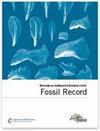下载PDF
{"title":"The macrosemiiform fish companion of the Late Jurassic theropod Juravenator from Schamhaupten, Bavaria, Germany","authors":"Gloria Arratia, Hans-Peter Schultze","doi":"10.1002/mmng.201200001","DOIUrl":null,"url":null,"abstract":"<p>A new neopterygian fish, <i>Voelklichthys comitatus</i> n. gen. n. sp., is described. The fish was found during the preparation of the theropod <i>Juravenator starki</i> Göhlich & Chiappe, 2006 in the same rock. The fish possesses numerous autapomorphies. The combination of autapomorphies is unique among Jurassic fishes and makes its taxonomic assignment difficult. The following characters are few examples demonstrating some of the peculiarities of the fish: The fish is small, oblong-shaped and has a large triangular head that is deeper than long; deepest point is at the level of the postparietal bone [parietal of traditional terminology] and the ventral end of the cleithrum. The skull roof is almost vertically oriented, with a strongly ossified and developed antero-dorsal orbital margin. Premaxilla and dentary possess very small conical teeth. The opercular apparatus is markedly narrow and deep. A clavicle is present. Both dorsal and ventral postcleithra are almost as deep as the maximum depth of the head; the dorsal postcleithrum is two times deeper than the ventral one. The vertebral centra are of arcocentral-type formed mainly by the development of the dorsal arcocentra. Pectoral and pelvic fins possess long rays that extend onto the pelvic and anal fins, respectively, whereas the rays of the dorsal and anal fins extend onto the caudal fin. The fish is interpreted as a macrosemiiform because it presents two of the three synapomorphies of the group (e.g., an incomplete circumorbital ring because the lateral edge of parietal bone [frontal of traditional terminology] makes up part of orbital margin and absence of a supramaxillary bone). The third macrosemiiform synapomorphy cannot be determined in the new fish because the coronoid bones and their dentition are not observed due to condition of preservation. The new fish shares a few characters with members of the families Macrosemiidae and the Uarbryichthyidae but lacks others so that presently, we place it in a family indeterminate within Macrosemiiformes. (© 2012 WILEY-VCH Verlag GmbH & Co. KGaA, Weinheim)</p>","PeriodicalId":55147,"journal":{"name":"Fossil Record","volume":"15 1","pages":"5-25"},"PeriodicalIF":1.4000,"publicationDate":"2012-02-21","publicationTypes":"Journal Article","fieldsOfStudy":null,"isOpenAccess":false,"openAccessPdf":"https://sci-hub-pdf.com/10.1002/mmng.201200001","citationCount":"6","resultStr":null,"platform":"Semanticscholar","paperid":null,"PeriodicalName":"Fossil Record","FirstCategoryId":"89","ListUrlMain":"https://onlinelibrary.wiley.com/doi/10.1002/mmng.201200001","RegionNum":4,"RegionCategory":"地球科学","ArticlePicture":[],"TitleCN":null,"AbstractTextCN":null,"PMCID":null,"EPubDate":"","PubModel":"","JCR":"Q3","JCRName":"Earth and Planetary Sciences","Score":null,"Total":0}
引用次数: 6
引用
批量引用
Abstract
A new neopterygian fish, Voelklichthys comitatus n. gen. n. sp., is described. The fish was found during the preparation of the theropod Juravenator starki Göhlich & Chiappe, 2006 in the same rock. The fish possesses numerous autapomorphies. The combination of autapomorphies is unique among Jurassic fishes and makes its taxonomic assignment difficult. The following characters are few examples demonstrating some of the peculiarities of the fish: The fish is small, oblong-shaped and has a large triangular head that is deeper than long; deepest point is at the level of the postparietal bone [parietal of traditional terminology] and the ventral end of the cleithrum. The skull roof is almost vertically oriented, with a strongly ossified and developed antero-dorsal orbital margin. Premaxilla and dentary possess very small conical teeth. The opercular apparatus is markedly narrow and deep. A clavicle is present. Both dorsal and ventral postcleithra are almost as deep as the maximum depth of the head; the dorsal postcleithrum is two times deeper than the ventral one. The vertebral centra are of arcocentral-type formed mainly by the development of the dorsal arcocentra. Pectoral and pelvic fins possess long rays that extend onto the pelvic and anal fins, respectively, whereas the rays of the dorsal and anal fins extend onto the caudal fin. The fish is interpreted as a macrosemiiform because it presents two of the three synapomorphies of the group (e.g., an incomplete circumorbital ring because the lateral edge of parietal bone [frontal of traditional terminology] makes up part of orbital margin and absence of a supramaxillary bone). The third macrosemiiform synapomorphy cannot be determined in the new fish because the coronoid bones and their dentition are not observed due to condition of preservation. The new fish shares a few characters with members of the families Macrosemiidae and the Uarbryichthyidae but lacks others so that presently, we place it in a family indeterminate within Macrosemiiformes. (© 2012 WILEY-VCH Verlag GmbH & Co. KGaA, Weinheim)
德国巴伐利亚州沙姆豪普滕晚侏罗世兽脚亚目Juravenator的大型半形鱼类伴侣
本文报道了一种新翅目鱼,Voelklichthys comitatus n. gen. n. sp。这条鱼是在准备兽脚亚目恐龙Juravenator starki Göhlich &Chiappe, 2006年在同一块岩石里。这种鱼具有许多自异形。自异形的结合在侏罗纪鱼类中是独特的,这使得其分类分配变得困难。以下是展示这种鱼的一些特点的几个例子:这种鱼很小,呈椭圆形,有一个大的三角形头部,深度大于长度;最深点位于顶骨后(传统术语为顶骨)和锁骨腹端。颅顶几乎垂直定向,具有强烈的骨化和发达的眶前背缘。前上颌骨和近齿具有非常小的锥形牙齿。眼窝明显狭窄而深。有锁骨。背侧和腹侧的锁骨后几乎与头部的最大深度一样深;背侧的锁骨后比腹侧的深两倍。椎中心主要由背椎中心发育而成的圆心型。胸鳍和腹鳍的长鳍分别延伸到盆鳍和肛鳍上,而背鳍和肛鳍的鳍则延伸到尾鳍上。这种鱼被解释为大半形鱼,因为它呈现出该组三种synapomorphies中的两种(例如,由于顶骨(传统术语的正面)的外侧边缘构成了眶缘的一部分,并且没有颌上骨,因此呈不完整的环眶环)。由于保存条件的限制,未观察到冠状骨及其齿列,因此无法确定新鱼的第三大半形突触形态。这种新鱼与大半鱼科和无鱼科成员有一些共同特征,但缺乏其他特征,因此目前我们将其置于大半鱼科中不确定的一个科中。(©2012 WILEY-VCH Verlag GmbH &KGaA公司,Weinheim)
本文章由计算机程序翻译,如有差异,请以英文原文为准。


